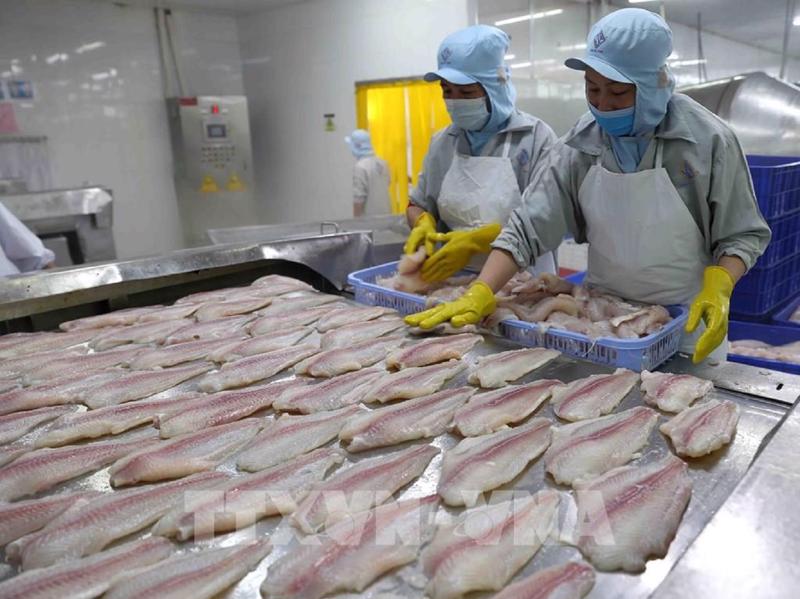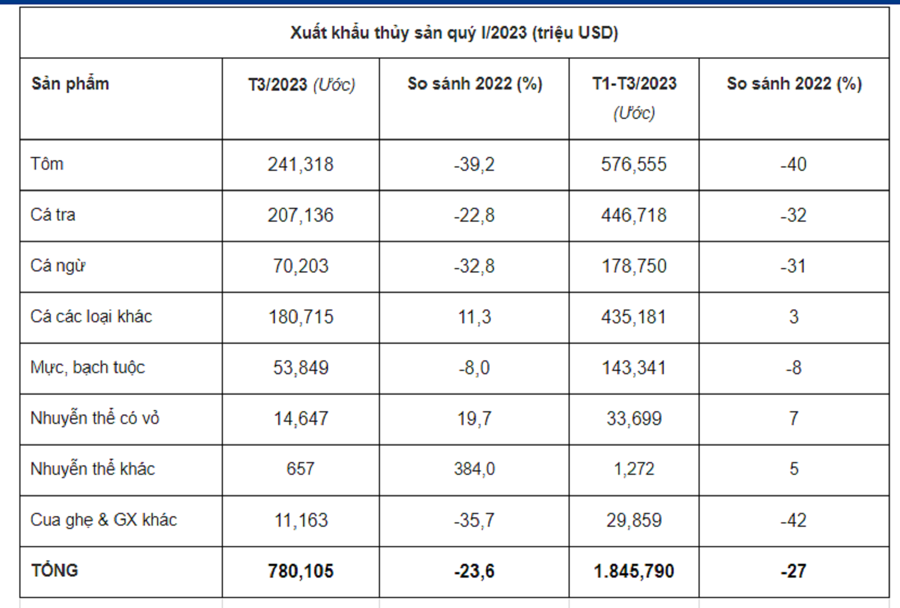SEAFOOD EXPORTS SET GROWTH EXPECTATIONS IN THE SECOND QUARTER OF 2023
Seafood export turnover in March 2023 reached 780 million USD, down 24% over the same period last year. In the first quarter of 2023, seafood exports reached about 1.85 billion USD, down 27% compared to the first quarter of 2022.

In the first quarter of 2023, exports of most key seafood products decreased from 8 to 39% compared to the same period in 2022.
According to the Vietnam Association of Seafood Exporters and Producers (VASEP), the world market is still heavily affected by inflation and the economic slowdown, which causes a decrease in seafood consumption demand, leading to export volume and prices. Vietnam's seafood in the first quarter of this year also decreased.
Notably, exports of most key seafood products decreased from 8 to 39%. In which, shrimp exports decreased by 39%, pangasius decreased by 23%, tuna decreased by 33%, squid and octopus decreased by 8%. However, exports of other marine fish species still grew by 11% year-on-year.
SHRIMP EXPORT 40% OFF, Pangasius 32% OFF
By the end of the first quarter, shrimp exports brought in 577 million USD, down 40%; pangasius export earned 447 million USD, 32% lower than the same period; and tuna exports decreased by 31% to only 179 million USD.
Meanwhile, the export turnover of squid and octopus was also 8% lower than the same period last year, reaching only 54 million USD. Particularly, the export of marine fish species still increased slightly by 3% to USD 435 million.

Giá trị xuất khẩu từng mặt hàng thủy sản trong quý 1, theo VASEP
Although inflation has cooled down, gasoline prices have decreased, but the production costs and prices of practical products in the United States are still high, so people still have to tighten their spending during this period, and tend to consume more products. lower priced products.
As a result, the average price of US seafood imports fell by more than 9% compared to the same period last year. By the end of March, Vietnam's seafood exports to the United States reached $237 million, down 55% over the same period last year. In which, shrimp alone accounted for 37%, tuna accounted for 23%, pangasius accounted for 17% and other marine fish products accounted for 15%.
“In the context of inflation, the US seafood import and consumption is increasing in proportion to the frozen segment and decreasing more in the value-added processed goods segment, so it will be difficult to make a breakthrough. break strongly in the coming months”, said VASEP.
Not only shrimp, for other seafood products, such as marine fish, squid, octopus... Vietnam also faces competition from exporters and seafood merchants from other countries. water.
In the first quarter of this year, seafood exports to China and Hong Kong reached nearly US$230 million, down 9% year-on-year (mainly because of a drop in January). Seafood exports to this market in February and March had good signals with an increase of 25% and 30%.
RECOVERY FROM Q2
Commenting on the market trends of some key seafood products in the first half of 2023, Ms. Le Hang said that seafood exports will likely recover gradually from the second quarter after international fairs take place. in the US and EU to attract more customers to Vietnam.
One highlight of the seafood market in March 2023 was a prominent event, the North American International Seafood Fair, which took place from March 12-14, 2023 with the participation of hundreds of businesses around the world. in the world, including 17 leading enterprises of Vietnam.
This year, the number of businesses participating in this fair increased sharply, especially in the Asia and Pacific region. Many traditional partners and new importers came to the fair with the desire to find new Vietnamese products. Therefore, this year's North American Fair promotes Vietnam's seafood trade with the US and other importing countries to recover from the first quarter.
VASEP forecasts that shrimp products will recover slowly because of fierce competition with India, Ecuador and Indonesia. Pangasius will be better in the context of inflation and economic decline in many markets and there will be more great opportunities after China fully reopens after Covid-19. Marine fish species continue to increase, including a growing contribution of processed goods exported from imported materials such as salmon, cod, pollock.
In major markets such as the EU and the United States, there is a tendency to increase the consumption of traditional products for Asian consumers and the export of dry goods (fish, shrimp, squid), fish sauce, fish cakes, canned goods, and so on. increase.
From the reality of market fluctuations, Ms. Le Hang recommends that businesses need to make reasonable adjustments to export products. With China in addition to frozen products, enterprises have taken advantage of geographical proximity to increase exports of shrimp and fresh seafood to the restaurant, hotel and tourism segments.
With other large markets such as the US and EU, businesses are more interested in the trend of importing goods for Asian supermarkets, and traditional Asian product lines such as: Dried goods, fish sauce, fish sauce ... still attracting customers.
In the context of the difficult market in 2023, enterprises are looking forward to the management agencies to help solve the immediate difficulties and inadequacies for businesses to stabilize the source of raw materials and promote exports, especially the policy and deploying preferential interest rates for farmers, fishermen and seafood processing enterprises”, emphasized Ms. Le Hang.
Mr. Truong Dinh Hoe, General Secretary of VASEP said that seafood processing and exporting enterprises should focus on products with high food safety, pay attention to consumption trends and increase product value.
While rival countries such as India and Ecuador focus on preliminarily processed products, Vietnam's achievements in recent years are thanks to businesses focusing on high value-added products.
According to Mr. Hoe, the world consumption trend is focusing on products that are good for health, are environmentally friendly and promote the circular economy. Therefore, the seafood industry needs to develop according to a green economic model, focusing on sustainable farming, such as the model of rice shrimp, wild shrimp, etc. to create sustainable farming products to convince world customers. On the other hand, it is necessary to focus on processing new products from by-products, increasing the competitiveness of Vietnamese seafood.
